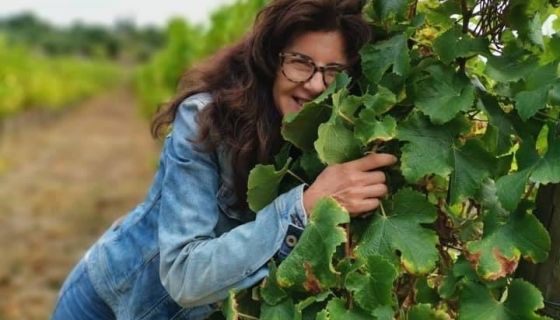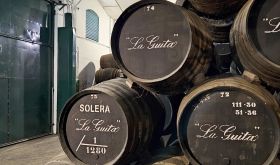From €10.50, $21.99, CA$39.99, £24.99, SG$105
When I suggested this wine to Jancis, she noted that it seems easier to find white wines that fit our WoW criteria (which are: good value, widely available, and deserving of a wider audience) than reds. I would add that Portuguese whites provide a particularly fertile hunting ground for this combination – and when trawling our database for past examples, I was pleased to find that Jancis featured this exact wine almost exactly ten years ago. Uncanny!
The winemaker Julia Kemper is pictured above hugging a vine, thanks to their Instagram page, and her Dão Branco has been reviewed four other times on these pages, scoring at least 17/20 on three occasions. However, I was quite oblivious to this when I opened a bottle that was kindly provided to me by Tuga, the Portuguese restaurant and wine importer in Singapore. All I had in mind was that a six-year-old white from a relatively warm part of Portugal was likely to be either a big hit or a big miss…
Swirl, sniff, sip … a hit, a very palpable hit!
It is so nice when that happens: that unexpected wave of enjoyment from a wine that not only tingles all your favourite taste buds but reminds you of the witchcraft magic that grapes can create.
The aromas are desiccated versions of their youthful selves: crystallised, resinous, full of antique charm, offset by exotic floral scent. On the palate, it had the oiliness more reminiscent of Loire Chenin or Rhône Roussanne than the fine white burgundy it has previously been compared with.
The grapes involved are in fact an equal blend of Encruzado and Malvasia Fina, grown organically and with certain biodynamic practices. Winemaking is simple, with maturation in new French oak, although only for three months.
The overall impact is bold and flamboyant, yet savoury and gastronomic too. It's full in body, with moderate acidity, but perfectly poised, and it is very well suited to the sort of traditional fare that Tuga serves: octopus salad so fresh that it almost wriggles, calorific francesinha (Portugal's answer to the croque-monsieur) and the saltiest cod fishcakes you've ever encountered.
I emailed Julia Kemper to ask if the wine is deliberately released with bottle age, and she replied that it is, explaining that oxygen contact is minimised during vinification, so that after bottling, the gradual oxygen ingress via cork helps develop complexity. She adds that her uncles and grandfather used to repeat to her that grapes don't need special treatment during production to reflect their terroir; and that wine 'should rest in bottle' for years.
On a more practical note, Julia also revealed that 'I had to consider whether I would have [enough] money to keep making wine and ageing it for some years before starting to sell it. So I did some calculations and concluded that I could recover my money with the same risk as if the money was deposited in a bank (actually my investments in the estate came from money I removed from a bank that went bankrupt).' This is the other, less trendy side of sustainability in wine: cash flow!
Even though this wine is made in limited quantities, it is available in several markets, covering a range of vintages. The 2017 vintage is the most recent release, although it’s apparently available only in Portugal itself so far. The 2016 is on sale in Canada, Germany, the UK and Spain, while the US has access only to the 2015, according to wine-searcher. Judging by the scores in our database, this is a wine that can be trusted every vintage.
See Julia Harding MW's reviews of dozens more excellent Portuguese wines, and look out for her forthcoming collection of 100 more.















